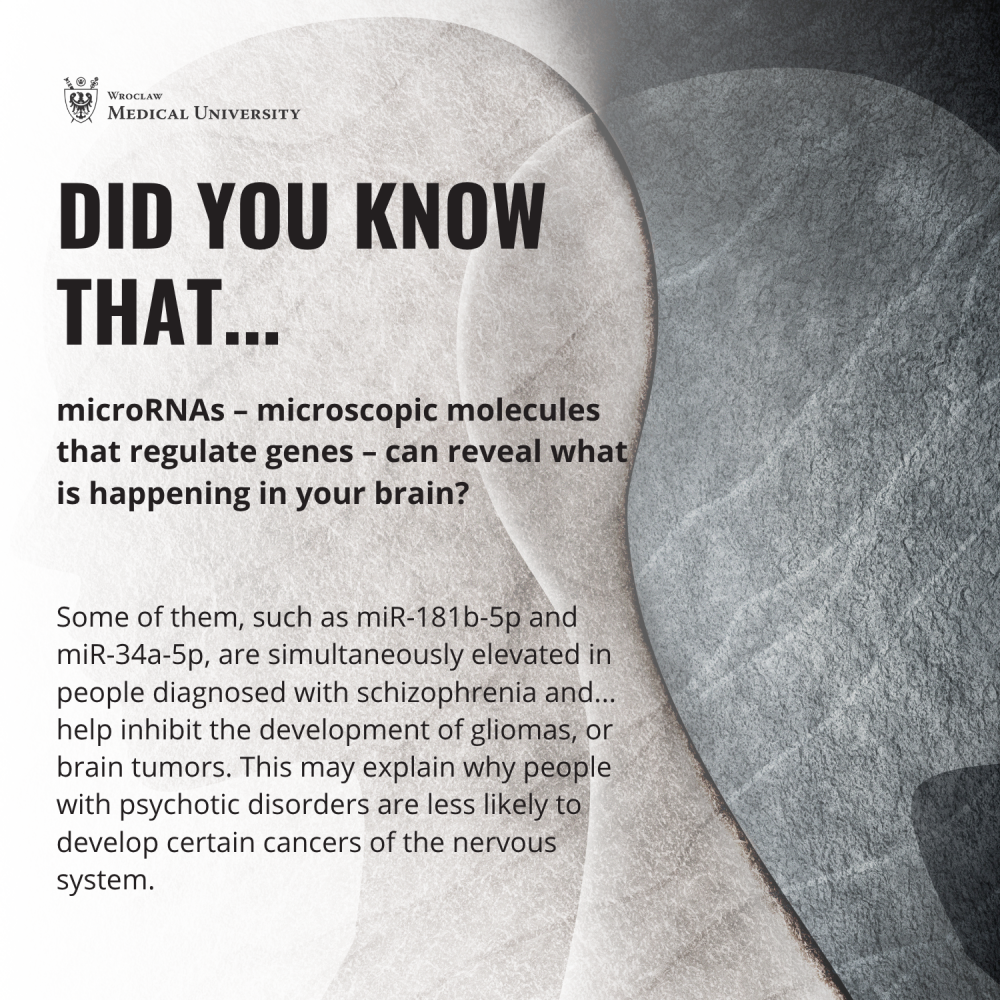Schizophrenia is one of the most complex and mysterious mental illnesses. Although it has been known for years that it has a strong genetic basis, doctors still do not have any biomarkers that would unequivocally confirm the diagnosis. It is based on the observation of symptoms – auditory hallucinations, delusions, and thought disorders. Science is searching for answers and may have found the right lead. The latest review of research suggests that the answers may lie in molecules so small that they fit into cellular “letters” – microRNAs.
A team of scientists from the Institute of Immunology and Experimental Therapy and Wroclaw Medical University has published a systematic review of research on microRNAs in schizophrenia and related psychotic disorders. This is the first such comprehensive analysis to combine the results of studies conducted on both blood and brain tissue samples. The conclusions are surprisingly consistent, despite the dispersion of data and methodological differences between studies.
What are microRNAs?
MicroRNAs are short, non-coding RNA molecules that do not build proteins but regulate gene activity, like editors who decide which parts of a book will go to print. They act as silencers: they mute the expression of specific genes, affecting the functioning of entire biochemical pathways. They are susceptible to environmental influences, stress, infections, and diet. Therefore, they are considered potential carriers of information about the state of the body and even the psyche.
Blood and brain – a common language
The authors of the review analyzed 77 scientific studies in which a total of 124 microRNAs with altered expression were identified in people with schizophrenia spectrum disorders. Significantly, some of these molecules were disrupted in both types of samples – blood and brain. This is essential information because it indicates that it is possible to detect pathological changes in easily accessible samples without having to resort to brain material.
The most consistent results concerned two microRNAs: miR-181b-5p and miR-34a-5p. Both were found in elevated amounts in people diagnosed with schizophrenia in as many as 8 out of 10 studies analyzed. The molecules in question are closely related to apoptosis, or programmed cell death, neuroplasticity, and nerve cell survival. Their disruption can therefore affect the delicate balance in the brain.
“In the context of both molecules, consistent changes in expression were most often observed in both the brain and peripheral blood, suggesting their potential diagnostic usefulness,” comments Marek Kotas, MD, from the Institute of Immunology and Experimental Therapy. – For miR-181b-5p, two studies showed that in a group of people with schizophrenia who had not taken antipsychotic drugs for at least 3 months before inclusion in the study, the level of miR-181b-5p significantly decreased after 6 weeks of pharmacotherapy. One of the studies also showed that reduced expression of this micoRNA was correlated with clinical improvement in negative symptoms,” he adds.
Biomarkers of the future
Scientists emphasize that it is not just about confirming the existence of differences. The study used the so-called AUC analysis, which is a statistical measure of “diagnostic accuracy.” For selected microRNAs, this indicator reached as high as 0.98. In practice, this means that their levels can very accurately distinguish between sick and healthy individuals.
This raises hopes that microRNAs could serve as psychiatric biomarkers in the future, tools to support diagnosis, assess disease progression, and predict response to treatment. What is more, these molecules can be detected in a simple blood sample.
“First and foremost, large, independent studies are needed to validate the proposed biomarkers – both to verify their sensitivity and specificity and to determine the range of normal values,” says Dr. Marek Kotas. “Without such studies, the measurement of microRNA expression will not be useful in clinical practice. There is also a cost barrier – microRNAs are not currently routinely assessed in diagnostic tests, and their expression is measured using advanced molecular techniques that are still relatively expensive,” he adds.

MicroRNA and oncology
MicroRNAs, which researchers associate with schizophrenia, are no less interesting in the context of cancer.
“There are interesting reports of reduced incidence of central nervous system tumors in people with schizophrenia,” says Prof. Błażej Misiak from the Department of Psychiatry at Wroclaw Medical University As he explains, “the expression of miR-181b-5p and miR-34a-5p is reduced in low-grade gliomas, while their overexpression usually has an anticancer effect.”
In the case of miR-181b-5p, it has been shown that it can inhibit the growth and migration of glioblastoma cells, probably by influencing the PI3K/AKT and MAPK/ERK pathways – mechanisms that regulate cell survival and division. Furthermore, these same pathways also show reduced activity in the brains and lymphocytes of people with schizophrenia.
“Although more detailed research is needed, there appears to be a link between the overexpression of these microRNAs and a lower risk of gliomas, possibly through mechanisms that promote the death of nerve or glial cells. However, this is largely speculation at this point,” the professor cautions.
In the search for the biological language of schizophrenia, microRNAs seem to be speaking more and more clearly. Their links to cancer mechanisms show how complex and multidimensional the processes governing our mental and somatic health are. Now we need to learn this language – and see if it can become a new tool in the hands of psychiatrists, biologists, and oncologists.
This material is based on an article:
A systematic review of miRNA expression in schizophrenia spectrum disorders across the blood and the brain.
Neuroscience & Biobehavioral Reviews
Authors: Marek Kotas, Bartłomiej Stańczykiewicz, Bartłomiej Sporniak, Edyta Pawlak, Błażej Misiak
https://doi.org/10.1016/j.neubiorev.2025.106292